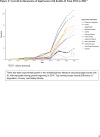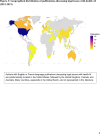Cracking the code: a scoping review to unite disciplines in tackling legal issues in health artificial intelligence
- PMID: 40216451
- PMCID: PMC11987151
- DOI: 10.1136/bmjhci-2024-101112
Cracking the code: a scoping review to unite disciplines in tackling legal issues in health artificial intelligence
Abstract
Objectives: The rapid integration of artificial intelligence (AI) in healthcare requires robust legal safeguards to ensure safety, privacy and non-discrimination, crucial for maintaining trust. Yet, unaddressed differences in disciplinary perspectives and priorities risk impeding effective reform. This study uncovers convergences and divergences in disciplinary comprehension, prioritisation and proposed solutions to legal issues with health-AI, providing law and policymaking guidance.
Methods: Employing a scoping review methodology, we searched MEDLINE (Ovid), EMBASE (Ovid), HeinOnline Law Journal Library, Index to Foreign Legal Periodicals (HeinOnline), Index to Legal Periodicals and Books (EBSCOhost), Web of Science (Core Collection), Scopus and IEEE Xplore, identifying legal issue discussions published, in English or French, from January 2012 to July 2021. Of 18 168 screened studies, 432 were included for data extraction and analysis. We mapped the legal concerns and solutions discussed by authors in medicine, law, nursing, pharmacy, other healthcare professions, public health, computer science and engineering, revealing where they agree and disagree in their understanding, prioritisation and response to legal concerns.
Results: Critical disciplinary differences were evident in both the frequency and nature of discussions of legal issues and potential solutions. Notably, innovators in computer science and engineering exhibited minimal engagement with legal issues. Authors in law and medicine frequently contributed but prioritised different legal issues and proposed different solutions.
Discussion and conclusion: Differing perspectives regarding law reform priorities and solutions jeopardise the progress of health AI development. We need inclusive, interdisciplinary dialogues concerning the risks and trade-offs associated with various solutions to ensure optimal law and policy reform.
Keywords: Artificial intelligence; Delivery of Health Care; Global Health; Health Equity; Machine Learning.
© Author(s) (or their employer(s)) 2025. Re-use permitted under CC BY-NC. No commercial re-use. See rights and permissions. Published by BMJ Group.
Conflict of interest statement
Competing interests: None declared.
Figures





References
-
- Geneva: World Health Organization; 2023. Regulatory considerations on artificial intelligence for health, licence: CV BY-NC-SA 3.0 IGO.
-
- American medical association principles for augmented intelligence development, deployment, and use. 2023. [12-Dec-2023]. https://www.ama-assn.org/press-center/press-releases/ama-issues-new-prin... Available. Accessed.
-
- Royal College of Physicians and Surgeons of Canada Task force report on artificial intelligence and emerging digital technologies. 2020. [26-Jun-2023]. https://cdn.dal.ca/content/dam/dalhousie/pdf/faculty/medicine/department... Available. Accessed.
Publication types
MeSH terms
LinkOut - more resources
Full Text Sources
Medical
